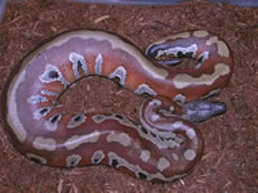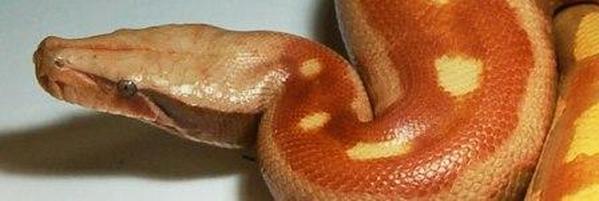Blood PythonPython brongersmai |

Custom Search
|
The species is found in tropical forests, palm plantations, and tropical swamps and marshes in the Malaysian peninsula, eastern Sumatra, and outlying islands.
There are some unconfirmed reports stating that these snakes may be found in other countries like Singapore, but it is more likely that they were introduced by humans. Adult blood python males typically range from 36 to 60 inches (91–152 cm) in length, females are smaller and reach between 48 to 72 inches (120–180 cm). Some specimens have been recorded to reach 96 inches (240 cm) in length. The blood python is a heavy-bodied snake with a thick, muscular body and variable markings and coloration. They have flat, broad and long heads very distinct and wider than the neck. These are unique snakes with a huge girth relative to their length due to this robust structure, they look somewhat overweight and older specimens can weigh 20 pounds (9 Kg) or more. The body color ranges from tan, brown, yellow to a cherry red, bright red or oxblood covered with lighter gold, tan, gold or orange and black blotches and stripes. The belly is usually white, very often with small blackish markings The head is usually gray, although some specimens may exhibit a black or even reddish head, they are also known for their changing head colors. So a black-headed snake in the morning could have a very pale, faded head coloration in the evening and vice versa.

These snakes are primarily crepuscular animals and are usually active at dawn and dusk.
They spend most of their time underwater waiting for prey to pass by. Then use heat-sensing pits, similar to those of venomous pit vipers, to detect their warm-blooded prey. In the past, they were considered to be generally unpredictable and aggressive, when most specimens held in captivity were wild-caught adult snakes from Malaysia. Today most blood python juveniles available in the pet trade are captive-hatched, originating from gravid females caught in the wild, that then lay and hatch their eggs in captivity. For these reasons, blood pythons are gaining popularity among herpetoculturists, breeders and snake enthusiasts due to their smaller size and the introduction of some amazing new color and pattern morphs. Their longevity in the wild is unknown, but probably around 20 years, in captivity even more than 25 years. Species / Taxonomy The short-tailed python group consists of 3 beautiful and closely related snake species. Beside the blood pythons (P. brongersmai) there's the Borneo short-tailed python (P. breitensteini) and the Sumatran short-tailed pythons (P. curtus). When it was first described in 1938 the species was considered a subspecies of the Short-Tail Python (Python curtus), but since 2001 it was elevated to a full species based on its morphological and genetic differences. The species specific name "brongersmai" was given in honor of Dutch herpetologist Leo Brongersma. Diet / Feeding
The blood python feeds mainly on small mammals, rodents like rats but also birds. These stealthy snakes, strike suddenly from concealment, seizing the prey and killing it by constriction. Reproduction Blood pythons are oviparous snakes, meaning females lay eggs. This species reproduces biennially, with females producing 12 to 16 eggs, however, larger clutches have been reported with up to 30 eggs being laid. Females of this species like other pythons will coil around the eggs and shiver her body, producing heat to help incubate the eggs. But since this demands a lot of energy they will only do so if ambient temperatures drop below 90 degrees Fahrenheit. A female may lose up to half its body weight during the incubation period. The eggs hatch after a period of 70 to 80 days and the hatchlings are 12 to 18 inches (30 to 45 centimeters) in length. The blood python becomes sexually active at 2 to 4 years of age and a length of 3 to 5 feet. Conservation / Threats The blood python is listed as Least Concern species by the IUCN. This is due to the species increasing population and wide distribution, it is found in protected areas but also capable of thriving in human-modified habitats. The main threat to the species is the possible overexploitation for pet and leather trade since it's heavily harvested in some parts its range. The population numbers must be monitored to ensure sustainable levels of harvest. The blood python is listed on CITES Appendix II.
|
Did You Know?
Because of the "Mojave toxin" the Mojave rattlesnake venom is regarded as the most toxic of any rattlesnake. Scientific classification |
© 2014 Snake Facts About Us | Privacy Policy | Contact




